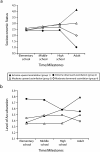Lifetime segmented assimilation trajectories and health outcomes in Latino and other community residents
- PMID: 20167890
- PMCID: PMC2836354
- DOI: 10.2105/AJPH.2009.167999
Lifetime segmented assimilation trajectories and health outcomes in Latino and other community residents
Erratum in
- Am J Public Health. 2011 Jan;101(1):6
Abstract
Objectives: Under an ecodevelopmental framework, we examined lifetime segmented assimilation trajectories (diverging assimilation pathways influenced by prior life conditions) and related them to quality-of-life indicators in a diverse sample of 258 men in the Phoenix, AZ, metropolitan area.
Methods: We used a growth mixture model analysis of lifetime changes in socioeconomic status, and used acculturation to identify distinct lifetime segmented assimilation trajectory groups, which we compared on life satisfaction, exercise, and dietary behaviors. We hypothesized that lifetime assimilation change toward mainstream American culture (upward assimilation) would be associated with favorable health outcomes, and downward assimilation change with unfavorable health outcomes.
Results: A growth mixture model latent class analysis identified 4 distinct assimilation trajectory groups. In partial support of the study hypotheses, the extreme upward assimilation trajectory group (the most successful of the assimilation pathways) exhibited the highest life satisfaction and the lowest frequency of unhealthy food consumption.
Conclusions: Upward segmented assimilation is associated in adulthood with certain positive health outcomes. This may be the first study to model upward and downward lifetime segmented assimilation trajectories, and to associate these with life satisfaction, exercise, and dietary behaviors.
Figures



Similar articles
-
Segmented assimilation as a mechanism to explain the dietary acculturation paradox.Appetite. 2022 Feb 1;169:105820. doi: 10.1016/j.appet.2021.105820. Epub 2021 Nov 26. Appetite. 2022. PMID: 34843752 Free PMC article.
-
Segmented Assimilation: An Approach to Studying Acculturation and Obesity Among Latino Adults in the United States.Fam Community Health. 2017 Apr/Jun;40(2):132-138. doi: 10.1097/FCH.0000000000000143. Fam Community Health. 2017. PMID: 28207676 Free PMC article.
-
Is acculturation related to obesity in Hispanic/Latino adults? Results from the Hispanic community health study/study of Latinos.J Obes. 2015;2015:186276. doi: 10.1155/2015/186276. Epub 2015 Mar 29. J Obes. 2015. PMID: 25893114 Free PMC article.
-
Nutrition Label Use and Its Association With Dietary Quality Among Latinos: The Roles of Poverty and Acculturation.J Nutr Educ Behav. 2018 Oct;50(9):876-887. doi: 10.1016/j.jneb.2018.05.019. J Nutr Educ Behav. 2018. PMID: 30297015 Free PMC article.
-
Acculturation and Latino health in the United States: a review of the literature and its sociopolitical context.Annu Rev Public Health. 2005;26:367-97. doi: 10.1146/annurev.publhealth.26.021304.144615. Annu Rev Public Health. 2005. PMID: 15760294 Free PMC article. Review.
Cited by
-
Measures of social deprivation that predict health care access and need within a rational area of primary care service delivery.Health Serv Res. 2013 Apr;48(2 Pt 1):539-59. doi: 10.1111/j.1475-6773.2012.01449.x. Epub 2012 Jul 20. Health Serv Res. 2013. PMID: 22816561 Free PMC article.
-
Assessment of acculturation in minority health research.Soc Sci Med. 2017 Mar;176:123-132. doi: 10.1016/j.socscimed.2017.01.029. Epub 2017 Jan 21. Soc Sci Med. 2017. PMID: 28135691 Free PMC article. Review.
-
Assessment of sexually transmitted disease/HIV risk among young African Americans: comparison of self-perceived and epidemiological risks utilizing ecodevelopmental theory.HIV AIDS (Auckl). 2019 Feb 20;11:31-44. doi: 10.2147/HIV.S189482. eCollection 2019. HIV AIDS (Auckl). 2019. PMID: 30863188 Free PMC article.
-
Acculturation and health: the moderating role of socio-cultural context.Am Anthropol. 2017 Sep;119(3):405-421. doi: 10.1111/aman.12867. Epub 2017 Aug 14. Am Anthropol. 2017. PMID: 28966344 Free PMC article.
-
Acculturation, nutrition, and health disparities in Latinos.Am J Clin Nutr. 2011 May;93(5):1163S-7S. doi: 10.3945/ajcn.110.003467. Epub 2011 Mar 2. Am J Clin Nutr. 2011. PMID: 21367946 Free PMC article. Review.
References
-
- Redfield R, Linton R, Herskovitz M. Memorandum for the study of acculturation. Am Anthropol 1936;38:149–152
-
- Berry JW. Conceptual approaches to acculturation. : Chun KM, Organista PB, Marin G, Acculturation: Advances in Theory, Measurement, and Applied Research Washington, DC: American Psychological Association; 2003:17–37
-
- Thomson MD, Hoffman-Goetz L. Defining and measuring acculturation: a systematic review of public health studies with Hispanic populations in the United States. Soc Sci Med 2009;69(7):983–991 - PubMed
-
- Cabassa LJ. Measuring acculturation: where we are and what we need to do. Hisp J Behav Sci 2003;25(2):127–146
Publication types
MeSH terms
Grants and funding
LinkOut - more resources
Full Text Sources

